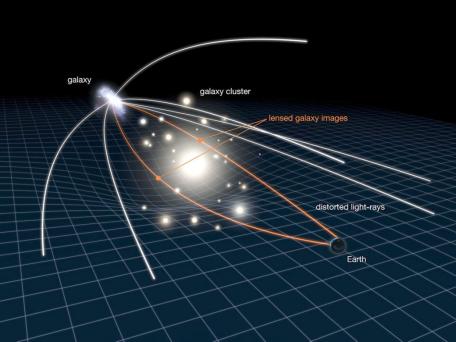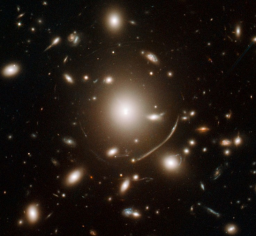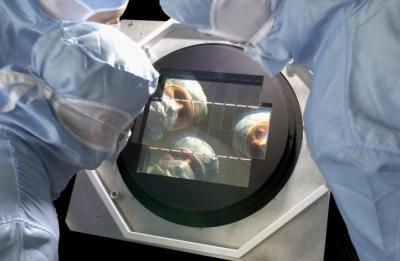An international collaboration of astrophysicists, led by Martin Kilbinger from the Astrophysics Division - AIM Laboratory AIM at CEA Saclay-Irfu and the Institute of Astrophysics Paris, has obtained the largest survey of galaxy images that are deformed by gravitation.
More than 4.2 million galaxies have been observed during more than 500 nights at the Canada-France Hawaii Telescope (CFHT) with the camera MegaCam, built at the CEA. The fine analysis of these images is the goal of the CFHTLenS project [1]. The very small distortions of galaxy images allowed to determine the fraction of dark matter and dark energy in a slice of the Universe between 2.4 and 8.8 billion years in the past, with a unprecedented level of precision. These results are complementary to those recently obtained by the Planck satellite at great distances from the analysis of the diffuse microwave background. This work is in press in the journal Monthly Notices of the Royal Astronomical Society (2013).
Gravitational lensing
Within the framework of the Big Bang cosmology, 95% of the content of the Universe is unknown. According to the recent results of the Planck satellite (ESA), only 4,9% is ordinary matter in the form of planets, stars, and gas. 26,8% consists of invisible matter. This so-called "dark matter" forms the cosmic web on which galaxies are lined up like water drops on a spider net. The remaining part, a little more than two thirds, is composed of a mysterious substance, the so-called "dark energy", which is diffusely distributed all over the cosmos. This substance causes the Universe to grow faster and faster.
The best way to measure the influence of dark matter and dark energy is to look at images of distant and faint galaxies. According to Einstein's theory of General Relativity, light is bend by matter. This causes optical distortions and magnifications of images, as if looking through an imperfect magnifying glass. This method of "gravitational lensing" is one of the best tools to detect the invisible components of our Universe. These distortions are however tiny, and can only be seen on very high-quality images from large optical telescopes, using sophisticated image analysis techniques.

According to the theory of General Relativity, light rays are distorted by matter. Where there is a high concentration of matter, such as in galaxy clusters, these distortions can be strong and cause amplifications of background galaxies, similar to a magnifying glass. This "gravitational lensing" effect also exists if matter is distributed in a more diffuse way as is the cosmic web. In that case the light distortions of distant galaxies is very small. The mapping of these distortions by the cosmic web is an indirect but powerful way to measure the influence of dark matter and dark energy. Credit: NASA, ESA, L. Calsada.
A large and precise survey
For the first time, a very precise measurement of these small deformations has been made available over an area on the sky of 154 square degrees, using over four million galaxies. The light from these galaxies was emitted in the distant past, between 2.4 and 8.8 billion years ago. This corresponds to the largest cosmic volume ever observed using gravitational lensing.
To achieve this survey, called CFHTLenS, more than 500 observing nights extended over five years were needed. The images were captured with the large CCD camera MegaCam with 375 million pixels, built at the CEA. These gravitational deformations of galaxy images are usually much smaller than distortions coming from the atmosphere, the telescope, and the camera. The CFHTLenS team has re-analysed all the data to make sure that the image quality meets the requirement. The modelling and correction of all image defects took the team of 25 people several years. In collaboration with mathematicians from CNRS statistical methods were used, which are also applied in the field of biology.
The nature of dark energy
This analysis allowed the researchers to measure the influence of dark matter and dark energy on the formation of the cosmic web and the geometry of the Universe. They determined that our cosmos has a flat geometry, in contrast to being curved, with a probaility of 50:1. This confirms hypotheses of the primordial universe. The result is complementary to the one recently obtained by the Planck satellite from the analysis of the diffuse microwave background. But while Planck observes the greatest structures at large distances, the "gravitational lensing" method reaches the smaller structures where the effect of gravity is stronger.
All images, data products, and analysis software codes have been made public to permit other researchers to make use of this survey. Previous analyses of a part of the data have already detected giant structures in the cosmic web. But only the precision of this new study allowed the team to go beyond established theories of the Universe. A companion publication tested certain alternative theories of gravitation that could explain dark energy by a modification of General Relativity.
Despite its size, the CFHTLenS survey covers less than 1% of the sky, the equivalent of two iPhones held at arm length. Larger surveys are already underway like the Kilo Degree Survey (KiDS) and the Dark Energy Survey (DES). In addition, astrophysicists are eagerly awaiting the launch of the space-mission Euclid, which will cover half of the sky to measure gravitational lensing deformations from the cosmic web with an unprecedented precision. Euclid was born from a French idea and was selected amongst 50 other competing projects. It is the second mission within the Cosmic Vision program of the European Space Agency (ESA) and it is planned to be launched in 2020.
Contact : Martin KILBINGER
see - the Press release CEA-CNRS-INSU-CFH-Université Diderot (10 avril 2013)
Publications :
"CFHTLenS: Combined probe cosmological model comparison using 2D weak gravitational lensing"
Martin Kilbinger, Liping Fu, Catherine Heymans, Fergus Simpson, Jonathan Benjamin, Thomas Erben, Joachim Harnois-Deraps, Henk Hoekstra, Hendrik Hildebrandt, Thomas D. Kitching, Yannick Mellier, Lance Miller, Ludovic Van Waerbeke, Karim Benabed, Christopher Bonnett, Jean Coupon, Michael J. Hudson, Konrad Kuijken, Barnaby Rowe, Tim Schrabback, Elisabetta Semboloni, Sanaz Vafaei, Malin Velander, in press in Monthly Notices RAS, for an electronic version : http://arxiv.org/abs/1212.3338
"CFHTLenS: Testing the Laws of Gravity with Tomographic Weak Lensing and Redshift Space Distortions", Fergus Simpson et al. , for an electronic version : http://arxiv.org/abs/1212.3339
see also : « Concentré d'Univers avec la caméra MegaCam », 26 octobre 2012
" Feu vert pour la mission spatiale Euclid", 20 june 2012
" Fresque cosmique - Carte de la matière noire" (7 January 2007)
and the CFHTLens website
EUCLID on the Sap website
the Consortium Euclid
Note :
[1] The CFHTLens project is an international collaboration led by Ludovic Van Waerbeke (University of British Columbia, Canada) and Catherine Heymans (University of Edinburgh, UK). The data are processed in collaboration with the TERAPIX Data Centre of the Institute of Astrophysics Paris (IAP), led by Yannick Mellier. See www.cfhtlens.org for more information.
Redaction: M. Kilbinger, J.M. Bonnet-Bidaud
• Structure and evolution of the Universe › Evolution of the large structures and galaxies
• Department of Astrophysics (DAp) // UMR AIM





